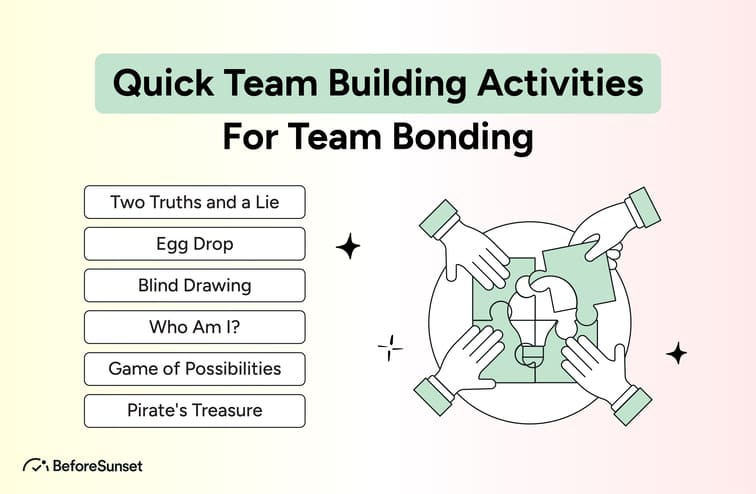In a world where things move quickly, team cohesiveness, camaraderie, and productivity may all be improved with short team-building exercises. For teams to function well in the changing work contexts of today, solid relationships are more crucial than ever. In addition to promoting a happy and cooperative environment, team building enhances performance and facilitates better problem-solving.
Time is important in workplaces, schools, and other group settings, and these short and efficient team-building exercises are perfect for fitting into hectic schedules.
This blog will walk you through a number of quick yet effective exercises that can help fortify the relationships on your team and have a long-lasting effect on morale and output. These quick tasks may be done during your lunch break or in a few minutes and can help you quickly create a more cohesive and stronger team.

What Are The 4 Main Types of Team Building Activities
Different sorts of team-building exercises can be distinguished according to their objectives and the areas of teamwork that they want to enhance. Although there are more than four other kinds of team-building exercises, these four are the most common ones:
1. Activities Centered on Communication:
The goal of these exercises is to strengthen team communication. Verbal communication, active listening, and non-verbal communication exercises are frequently included in them. Role-playing exercises like "Two Truths and a Lie," or charades or Pictionary, where team members must communicate without using words, are a few examples.
2. Activities for Solving Problems:
The goal of problem-solving exercises is to improve a team's capacity to collaborate to find solutions to challenging problems or riddles. Brain teasers, escape room puzzles, and outdoor scavenger hunts are a few examples of these kinds of games, where participants must work together to solve problems and accomplish a shared objective.
3. Building Trust Activities:
Activities aimed at fostering mutual trust and reliance among team members are called trust-building exercises. Emotional openness and physical interaction are common in these activities. Trust falls, blindfolded trust walks, and other exercises requiring team members to provide emotional or physical support to one another are a few examples.
4. Socialization and Team Building:
The goal of these exercises is to help team members develop closer personal bonds with one another. They frequently focus more on fostering a fun and good social environment within the team than they do on accomplishing certain tasks. Team meals, icebreaker activities, and team excursions or getaways are a few examples.
What Is A 5 Minute Icebreaker Activity?
A five-minute icebreaker activity is a quick and easy exercise some fun activities meant to help people unwind, get to know one another, and establish a good vibe before a meeting, workshop, or team-building activity. These are great ways to warm people up and break the ice because they are usually brief and playful.

Simple Team Building Activities and Games
Easy games and team-building exercises are effective ways to help people who collaborate in a variety of contexts communicate more effectively and develop a stronger sense of camaraderie. The team building games can even be virtual team building activities. So that remote employees can also benefit from employee engagement.
These virtual team building games and fun team building activities are an enjoyable and practical approach to improving the relationships among effective team members, regardless of whether you're a member of an athletic team, business team, classroom, or any other kind of group with a shared objective.
Easy team-building exercises and games provide the groundwork for more effective, harmonious, and cohesive teams by offering chances for shared experiences, problem-solving, and mutual support. It improves team spirit and help them achieve team goals faster.
1. Two Truths and a Lie
An icebreaker exercise known as "Two Truths and a Lie" invites players to reveal fascinating personal information while asking others to spot the falsehood. This is how this fun game functions:
Preparation: Prepare each participant by asking them to consider three assertions about themselves, two of which should be true and one of which untrue. Urge them to add something unique, humorous, or intriguing to these facts.
Sharing: In a group context, each person shares one of their three assertions with the group in turn. Presenting these claims should be done without identifying which is untrue. A participant may state, for instance, "I can speak three languages fluently, I've been to ten different countries, and I once won a baking competition."
Guessing and Discussion: Following each person's presentation of their claims, the group as a whole gets the chance to speculate or ask questions on which claim is false. As people attempt to identify the misleading information, this may spark interesting and entertaining conversations.
Reveal: After each participant has taken a chance, the group members declare which assertion was untrue. As the group gets to know one another better, this frequently causes astonishment and laughter.
2. Egg Drop
Popular and instructive, the "Egg Drop" is a team-building exercise that blends engineering, creativity, and problem-solving skills. The task for this project is to create a contraption or protective mechanism that can prevent a raw egg from shattering when dropped from a predetermined height. It's an enjoyable and participatory approach to include people or groups in a practical experiment that illustrates physics concepts and cooperation.
You'll need to obtain a range of materials for participants to build their protective gear in order to put up an Egg Drop activity. These materials can be more unusual, like cotton balls, bubble wrap, or even tiny parachutes, or more commonplace, such as straws, rubber bands, paper, and cardboard. The participant's job is to use these supplies to make a mechanism that, when hit, will efficiently cushion and shield the uncooked egg from harm.
The main goal is to make sure the egg doesn't break or crack when it's dropped from a specific height. Participants must exercise critical thought when designing their gadgets, taking into account elements like structural integrity, stress absorption, and the distribution of impact forces. They could try a variety of tactics, such as developing a protective shell, slowing the fall using a mechanism akin to a parachute, or employing different materials to cushion the impact.
The Egg Drop exercise may be modified to meet the group's unique aims and objectives. Resource management is added to the task when you specify conditions for success, such as a maximum budget for materials or a height from which the egg must stay intact.
The testing phase begins once the participants have constructed their egg protection equipment. They alternately drop their devices—which contain the eggs—from the set height. A lot of the time, this is an exciting and tense moment, with participants waiting to see if their design has been successful in keeping the egg safe.
A debriefing session follows the activity, during which participants share their insights, design decisions, obstacles encountered, and takeaways from the exercise. Through this contemplation, participants may make the connection between engineering and physics concepts and the practical applications of creativity, cooperation, and problem-solving.
The Egg Drop is a flexible and captivating team-building exercise that can be customized for various age groups, ability levels, and environments, including outdoor challenges and corporate team-building events. In addition to offering a practical learning experience, it promotes experimentation, teamwork, and critical thinking.

3. Blind Drawing
A straightforward and enjoyable team-building exercise that promotes cooperation, communication, and trust among participants is blind drawing. Participants in this exercise are paired off into teams, with one person assigned to the role of "drawer" and the other as "instructor." Without allowing the drawer to see what they are drawing, the instructor should be able to direct the drawer toward producing a particular drawing or picture.
Basic art equipment, such as paper and markers, are needed to set up the Blind Drawing activity. Participants should be positioned back to back to ensure that the drawer cannot see the instructor's work. An image that has already been drawn or a description of an image that has to be replicated is sent to the teacher, who then helps the drawer.
Effective communication is essential to this task. The drawer must listen to the teacher's detailed explanation of the image and follow the directions to replicate it on their own piece of paper. The drawer is blind and must follow the instructor's instructions only.
This is a project that may be customized to be as basic as sketching shapes and things or as sophisticated as more elaborate designs. The discrepancies between the final sketch and the initial image are frequently humorous to see because of misunderstandings, presumptions, and imaginative interpretations.
There are several uses for blind drawing when it comes to team development. It emphasizes the value of precise and unambiguous communication within a team, as participants soon discover that excellent guidance is necessary to accomplish the intended result. Because the drawer cannot see the progress or outcome of their work, they must rely on the instructor's instruction, which promotes active listening and trust.
The teams can compare their drawings and talk about the difficulties they had after finishing the sketch. Participants get the chance to consider the value of cooperation, communication, and the possibility of misunderstandings when instructions are unclear during this debriefing phase.
3. Who Am I?
"Who Am I?" is a well-liked and captivating icebreaker game that challenges players to identify a person or character using logical reasoning and yes-or-no questions. This is a great exercise to do at parties, team-building events, or educational settings since it encourages critical thinking and communication among the participants.
You will need to prepare in advance for the game "Who Am I?" by making a list of well-known individuals, fictional characters, or historical figures. Without any knowledge of their true identity, each participant is given one of these identities. The participant can't see the identification if it's put on a little card or sticky note and stuck to their back or forehead.
By posing yes-or-no questions to other players, it is each player's goal to determine their given identity in this game. For instance, if someone is given the name "Albert Einstein," they may wonder if they qualify as a scientist or if their contributions to physics are well-known.
Participants only get "yes" or "no" answers from other participants when they pose questions. They keep asking until they are able to estimate their identity with confidence. The game continues until a certain time limit is reached or when each player has recognized their character.
An adaptable icebreaker exercise that works well for a variety of themes or subjects is "Who Am I?" It may be customized to fit the interests of the group or the particular event. For example, in an educational context, you may select historical people associated with a specific course or topic. You might use the names of coworkers or prominent figures in the field.
In addition to promoting logical reasoning and critical thinking, the game also improves communication abilities and promotes social engagement. It's an entertaining and welcoming method to break the ice and get people involved in an exciting and dynamic activity.
You can hold a talk or debriefing session after the game to share some of the funny or thought-provoking things that happened throughout the game. Participants might consider the value of cooperation in problem-solving, the necessity of patience, and the significance of asking insightful questions. All things considered, "Who Am I?" is a fun and inventive icebreaker that may provide a feeling of humor and companionship to a variety of group events.

4. Game of Possibilities
A fun and imaginative team-building activity, the "Game of Possibilities" pushes participants to think creatively and improves their communication abilities. This exercise works especially well for improving group teamwork, improvisation, and problem-solving skills. It may be modified for use in a variety of contexts, including classroom exercises and corporate training sessions.
The Game of Possibilities requires a variety of commonplace items to play. These items can be anything ordinary that participants can quickly recognize, such as a pen, shoe, coffee cup, or stapler. A participant or group of participants receives one of these items from the facilitator. The assignment is to show off a variety of inventive applications for that thing without explicitly stating what its intended usage is.
If the object is a stapler, for instance, the participants could think of creative ways to utilize it, such as imagining it to be a microphone, a spacecraft engine, or a musical instrument. The secret is to demonstrate these alternate uses with enthusiasm and inventiveness. As they watch, the other members of the group attempt to deduce the intended applications.
Improvisation, inventiveness, and nonverbal communication are key components of the "Game of Possibilities". The ability to think quickly and communicate the different applications of the object through body language, gestures, and expressions is required of the participants. As they attempt to determine the intended applications, this encourages the group to practice active listening and observation.
In addition to encouraging creativity, this exercise assists participants in breaking away from ingrained thought habits. It inspires people to view things in fresh and creative ways, which may be a useful ability for brainstorming and problem-solving.
Because of how humorously the things might be interpreted, the game can also provide enjoyment and amusement. Following each round, the group might talk about the experience and the difficulties they had explaining the object's purposes.
6. Pirate's Treasure
An exciting and creative team-building exercise called "Pirate's Treasure" immerses players in a world of daring explorers and lost riches. This task promotes teamwork, communication, and problem-solving, which makes it a fun option for classrooms, parties, and group activities.
You must create a collection of clues or riddles that will guide players to the ultimate treasure location in order to set up the "Pirate's Treasure" activity. Clues might be scrawled on paper or tucked inside envelopes. Hopefully, the last hint will lead to the location of the "treasure."
Teams of participants are formed, and each team begins at a predetermined location. They receive the first clue, which points them in the direction of the second clue's location. They follow the second hint to find the third, and so on, until they arrive at the last prize spot.
An element of adventure and narrative should be incorporated into the game by connecting each clue or riddle to scenarios with a pirate theme. One clue may be, "X marks the spot where the treasure lies beneath the palm tree's shadow," directing searchers to a place where a palm tree and a large "X" are prominently displayed.
To find the hidden wealth, teams must cooperate to solve the puzzles, interpret the hints, and follow the trail. This might need imaginative problem-solving, clear communication, and the capacity to link one hint to the next.
You may adjust the "Pirate's Treasure" exercise to the group's preferred level of difficulty and length. Less clues leading to a straightforward reward can be used for shorter sessions, while more complex treasure hunts with more obstacles can be designed for longer ones.
Along with encouraging problem-solving and collaboration, this game makes players feel adventurous and closer to one another. It's a fun method to get people excited about a common goal and provides chances for thought and conversation about how crucial good communication and teamwork are to achieving it.
Connect With Your Team With BeforeSunset AI
Do you want to be on the same page with your team? Try BeforeSunset AI. Lead your team to reach the goals.


